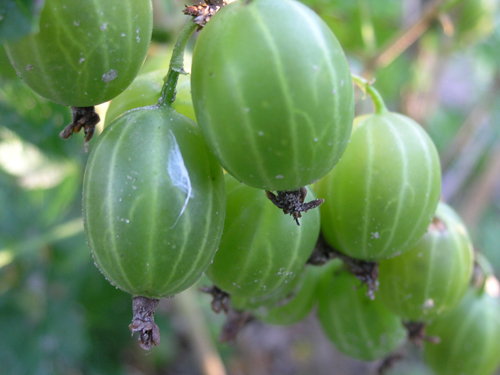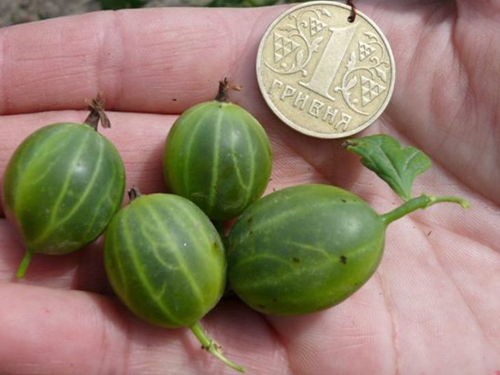Gooseberry variety Ural emerald
When studying frost-resistant gooseberry varieties, the name Ural emerald is often found. This species is relatively new, but has already established itself in regions where ordinary varieties are not very comfortable. The novelty was added to the State Register of Breeding Achievements of Russia in 2000. The applicant is the Federal State Budgetary Scientific Institution "South Ural Research Institute of Horticulture and Potato Growing". Regions of admission - West Siberian (Novosibirsk, Tomsk, Kemerovo, Tyumen, Omsk regions, Altai Republic and Altai Territory) and East Siberian (Republics of Buryatia, Sakha, Khakassia, Tyva, Krasnoyarsk and Transbaikal Territories, Irkutsk Region). The variety is recognized as promising not only for amateur gardening, but also for industrial.
Description
Shrub of moderate size, dense, not too sprawling. Thick gooseberry shoots grow straight, have a shiny green bark with traces of anthocyanin coloration in the upper part. The shoots of the Ural emerald are studded with thorns along the entire length, but, in general, the degree of prickling is not high. At the nodes, the thorns are one-, two- or three-part, medium-long, straight, light brown, dull, located mainly perpendicular to the shoot, less often downward or upward to the shoot. Often the upper nodes, from 1 to 3, are completely devoid of thorns. The internodes of the variety are smooth, without thorns. Oval buds are small, light brown, smooth, with a pointed tip, growing deviating from the shoot. The petiole trace is rounded. Gooseberry leaves of various sizes - from small to large, with a shiny and wrinkled surface, dark green, the leaf is concave along the middle veins. The shape of the plate is five-bladed; the cutouts between the blades are of regular size. The height of the middle lobe exceeds the lateral ones; the apices of the lobes are obtuse. The middle veins of the lateral lobes make an acute angle, the lateral lobes are not wide, of moderate length, directed slightly to the sides. The denticles are slightly curved, short or slightly longer, and sharp. The basal lobes are underdeveloped. The base of the sheet can be either straight or convex. The petiole is green, long, thin. The inflorescences of the Ural emerald consist of one large brightly colored flower. Sepals are unclosed, bent, dull pink.

Gooseberry fruits are one-dimensional, medium or large in size - from 3.5 to 7.5 or 8 grams, according to the State Register, the usual weight of a berry is 4.3 grams. The shape is rounded-oval, the skin is thin, without pubescence, the veins are white. The variety got its name due to the color of the fruit - bright, green. The calyx is medium, half-open. The peduncle is not long, moderately thick, green. The pulp is juicy, with a moderate amount of seeds. The taste is sweet or sweet and sour, assessed as excellent - 5 points. 100 grams of raw material contains: sugars - 9.3%, titrated acids - 2.2%, ascorbic acid - 20.5 mg.
Characteristics
- In the period of fruiting, the Ural emerald enters 3 - 4 years after planting;
- refers to varieties of early ripening, the crop can be harvested at the very beginning of July;
- gooseberries bear fruit for 15 to 20 years;
- yield, according to the State Register, is 87.8 c / ha. VNIISPK provides data on the average long-term yield, which is 7.0 t / ha, the maximum indicator is 18.6 t / ha. If you measure it with the usual measures for an ordinary gardener, then from 2.1 to 5.6 kg of berries are removed from the bush;
- self-fertility is not bad - the variety independently ties about 38.9% of the crop. To increase this indicator and improve the quality of the berries, it is advisable to plant several varieties nearby, for example, Beryl or Commander (Vladil);
- winter hardiness of the Ural emerald is excellent, for which it is valued. The bush can withstand frosts down to -37 ° С, especially if there is snow cover;
- good immunity - gooseberries are weakly affected by powdery mildew and anthracnose, resistant to pests - fireflies and sawflies;
- the crop is well transported;
- the way of eating berries is universal. Dessert-flavored fruits perfectly refresh in their natural form, strengthen the health of adults and children.In addition, they are suitable for various types of processing.

Planting and agricultural technology
Given that autumn is not soft in the regions of tolerance, it is best to plant seedlings in the spring. Until the winter period, the plant will have enough time to adapt to a new place. For good growth and fruiting of the variety, choose sunny, warm places, protected from the prevailing winds in winter. They are categorically not suitable for planting lowlands, where cold air accumulates and flooding periodically occurs, and areas with a high, above 1 meter, level of groundwater. The Ural emerald is not very picky about soils, but on acidified, heavy and cold soils it will grow poorly or even die. Due to the increased thickening, the shrub will have to be thinned annually, it is best to do this in the spring, before the start of the growing season. But if it was not possible to carry out pruning during this period, you can do it in the fall. After the formation of the bush, it is recommended to leave 10-15 branches of different ages, annually adding 3-4 young shoots to them. To avoid scratches and cuts during harvest, many gardeners grow the crop on a trellis or standard way. Standard gooseberries will also decorate the garden, as they look unusual. The rest of the care is standard - feeding, weeding, watering.
The Ural emerald is prized for its high yield, large fruit size and excellent taste. High winter hardiness and good immunity of the variety are also noted by gardeners. Thorns, of course, are a minus, but small in comparison with other characteristics.









In my conditions (Siberia, floodplain, high groundwater), the berry is gaining an excellent taste. The bush began to bear fruit 3 years after planting. It grows slowly, it does not work out immediately thickened, even if I would like to. Very fruitful, does not get sick at all, pours out only if it is completely overripe. I have not froze even once in 6 years from the moment of appearance (now we have long severe frosts, if it survives them, it will be a miracle). My thorniness is increased, but it does not interfere with picking berries - the branches are tough and erect, it is easy to get to the berries.